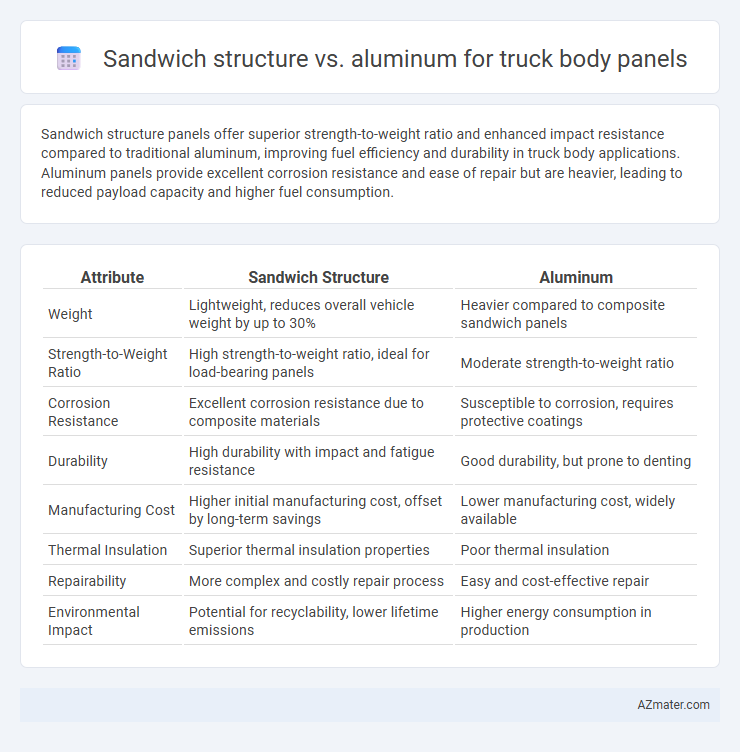Sandwich structure panels offer superior strength-to-weight ratio and enhanced impact resistance compared to traditional aluminum, improving fuel efficiency and durability in truck body applications. Aluminum panels provide excellent corrosion resistance and ease of repair but are heavier, leading to reduced payload capacity and higher fuel consumption.
Table of Comparison
| Attribute | Sandwich Structure | Aluminum |
|---|---|---|
| Weight | Lightweight, reduces overall vehicle weight by up to 30% | Heavier compared to composite sandwich panels |
| Strength-to-Weight Ratio | High strength-to-weight ratio, ideal for load-bearing panels | Moderate strength-to-weight ratio |
| Corrosion Resistance | Excellent corrosion resistance due to composite materials | Susceptible to corrosion, requires protective coatings |
| Durability | High durability with impact and fatigue resistance | Good durability, but prone to denting |
| Manufacturing Cost | Higher initial manufacturing cost, offset by long-term savings | Lower manufacturing cost, widely available |
| Thermal Insulation | Superior thermal insulation properties | Poor thermal insulation |
| Repairability | More complex and costly repair process | Easy and cost-effective repair |
| Environmental Impact | Potential for recyclability, lower lifetime emissions | Higher energy consumption in production |
Introduction to Truck Body Panel Materials
Truck body panels require materials that balance strength, weight, and durability for optimal performance. Sandwich structures, composed of two thin outer layers bonded to a lightweight core, offer superior stiffness-to-weight ratios and impact resistance compared to traditional aluminum panels. Aluminum, known for its corrosion resistance and ease of fabrication, remains widely used but often results in heavier panels with less structural efficiency than advanced sandwich composites.
Overview of Sandwich Structure Technology
Sandwich structure technology in truck body panels integrates lightweight core materials such as foam or honeycomb between two aluminum or composite face sheets, providing exceptional strength-to-weight ratios. This design enhances impact resistance, thermal insulation, and stiffness while reducing overall vehicle weight compared to traditional solid aluminum panels. The technology improves fuel efficiency and durability, making it a superior choice for modern truck body manufacturing.
Key Properties of Aluminum Panels
Aluminum panels in truck body construction offer exceptional strength-to-weight ratio, enhancing fuel efficiency and payload capacity. Their corrosion resistance ensures long-term durability and reduced maintenance costs compared to traditional materials. The material's excellent formability and recyclability contribute to sustainable manufacturing and versatile design options.
Weight Comparison: Sandwich Structure vs Aluminum
Sandwich structures significantly reduce the weight of truck body panels compared to traditional aluminum, offering a lightweight core material bonded between thin aluminum or composite skins. This design achieves enhanced strength-to-weight ratios, allowing for weight savings of up to 30-40% without compromising durability. Reduced panel weight directly improves fuel efficiency and payload capacity, making sandwich structures a superior choice over solid aluminum panels for heavy-duty vehicle applications.
Structural Strength and Durability
Sandwich structures, consisting of lightweight cores between aluminum or composite faces, offer superior structural strength-to-weight ratios compared to solid aluminum panels, enhancing impact resistance and load distribution in truck body panels. These panels provide increased durability through improved resistance to fatigue, corrosion, and deformation under dynamic stresses. Aluminum panels, while durable and corrosion-resistant, typically exhibit lower stiffness and strength-to-weight efficiency than modern sandwich composites, which extend service life and reduce maintenance costs in demanding truck applications.
Thermal and Acoustic Insulation Differences
Sandwich structures offer superior thermal insulation for truck body panels due to their core materials, such as foam or honeycomb, which reduce heat transfer more effectively than solid aluminum panels. Acoustic insulation is also enhanced in sandwich panels as the layered design dampens sound vibrations and reduces noise transmission compared to aluminum's high sound conductivity. Aluminum panels provide durability and lightweight benefits but fall short in thermal and acoustic insulation compared to advanced sandwich structures specifically engineered for these properties.
Corrosion Resistance and Longevity
Sandwich structures, typically composed of a polymer core bonded between metal or composite skins, offer superior corrosion resistance compared to traditional aluminum panels due to their moisture-resistant cores and protective outer layers. Aluminum panels, while lightweight and widely used in truck body applications, are prone to oxidation and require surface treatments to enhance corrosion resistance over time. The enhanced corrosion resistance of sandwich structures contributes to longer service life, reducing maintenance costs and improving durability in harsh environmental conditions.
Cost-Effectiveness and Maintenance Considerations
Sandwich structure panels offer superior cost-effectiveness for truck body applications by combining lightweight materials with high strength, reducing fuel consumption and overall operational costs. Aluminum panels, while durable and corrosion-resistant, often entail higher initial investment and increased maintenance expenses due to potential denting and surface repairs. Maintenance for sandwich structures is generally lower as their composite layers resist corrosion and damage better, minimizing long-term repair costs compared to aluminum.
Environmental Impact and Sustainability
Sandwich structures, composed of lightweight materials like foam cores bonded between metal or composite skins, offer superior environmental benefits compared to traditional aluminum truck body panels by reducing overall vehicle weight and improving fuel efficiency, which lowers greenhouse gas emissions. The manufacturing process of sandwich panels often involves less energy-intensive techniques and uses recyclable or bio-based core materials, enhancing sustainability profiles. Aluminum, while recyclable, requires high energy consumption during extraction and refining, leading to a larger carbon footprint, making sandwich structures a more eco-friendly solution for sustainable truck body panels.
Choosing the Optimal Material for Truck Bodies
Sandwich structures offer superior strength-to-weight ratios and enhanced energy absorption compared to traditional aluminum panels, making them ideal for reducing overall truck body weight and improving fuel efficiency. Aluminum, known for its corrosion resistance and ease of repair, provides durability and lower lifecycle costs, especially in harsh environmental conditions. Selecting the optimal material depends on balancing lightweight performance, structural integrity, cost-effectiveness, and maintenance requirements tailored to specific truck operational demands.

Infographic: Sandwich structure vs Aluminum for Truck body panel
 azmater.com
azmater.com